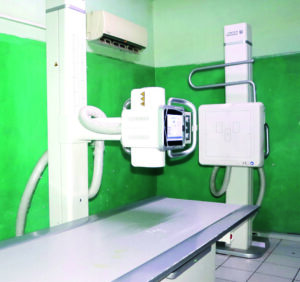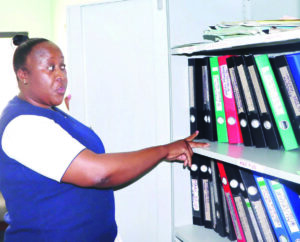By Leonard Masauli & Patricia Kapulula:

Zomba Central Hospital, located in the city of Zomba, can best be described as the mother of healthcare service delivery in the Eastern Region.
This is because its like a giant tree upon which several hospitals in its catchment area look up to.
However, for a long time, the country’s oldest referral hospital was being overwhelmed with clients, especially those that needed computed tomography (CT) scan services.
This is because most district hospitals that look up to Zomba Central Hospital did not have functioning machines, hence they could be quick to refer their patients to Zomba Central Hospital.
While some patients sought services from private hospitals, where they were paying a leg to access services, others could just resign to fate.
Their justification for taking that route could go like ‘I cannot afford bills that private healthcare service facilities demand’; ‘I do not have transport fare’; ‘I do not have money for food once I arrive at the hospital’, among others.
However, with the intervention of the Global Fund, which has, through the Government of Malawi, procured a K2 billion CT scan, pharma-grade incinerator, and a machine for the Infectious Diseases Unit (IDU), patients have seen a tremendous change as far as healthcare service provision is concerned.

During the commissioning ceremony at Zomba Central Hospital in July this year, Minister of Health, Khumbize Kandodo Chiponda said the ministry was determined to fight against diseases.
She said to achieve this enormous objective, it became imperative that Ministry of Health put in place necessary infrastructure and equipment.
Kandodo Chiponda also said the recruitment of healthcare workers, to carry out this enormous task, effectively was part of the equation.
“I feel privileged and honoured to inaugurate the CT scanning facility, the Medical Incineration Services Facility and the Infectious Disease Unit (IDU) at Zomba Central Hospital (ZCH).
“The CT scan—worth over K2 billion—and a pharma-grade incinerator installed at Kasungu District Hospital worth K453million, are courtesy of the support from the Global Fund,” Kandodo Chiponda pointed out.
She said the funds for such state-of-the-art machines were awarded to Malawi as part of the Covid response mechanism grant.
The grant was meant to strengthen health systems and make health infrastructure robust and resilient to future pandemics.
“We are thrilled that the Eastern Region community, where Zomba is, will now have enhanced access to care close to home. This state-of-the-art technology is a game-changer, eliminating the need for Eastern Region residents to travel to other centres for CT scanning.
“The CT scanner is not just a machine; it is a promise of prompt and accurate diagnoses and will aid in timely treatment, elevating the overall standard of care. It will reduce travel burdens for patients, and offer healthcare professionals enhanced capability to provide the best care possible.
A CT scan is a medical imaging test that uses X-rays to create cross-sectional images of the body.
The patient lies on a table that slides into the CT scanner.
A narrow X-ray beam rotates around the patient’s body to detect health conditions and injuries such as tumors, bone fractures and heart diseases.
Apart from Zomba Central Hospital, the Global Fund has donated a Digital X-ray Machine to improve health care provision at Queen Elizabeth Central Hospital (QECH) in Blantyre.
The hospital serves up to 230 patients per day and the inside body imaging device has improved the hospital’s service delivery by having consistent services since its commissioning in June this year.
QECH Chief Radiographer and Head of Radiography, George Mubisa, hailed the commissioning of the machine, saying it came at the right time when the hospital was overwhelmed with patients from district hospitals.
“This is a state-of-the-art technology which produces high quality images. It has the capability of artificial intelligence, such that it can analyse the chest X-ray and interpret results of the analysis and give scores in relation to the probability of a patient having tuberculosis (TB),” Mubisa said.
Besides pointing out suggestive TB, technology also gives other scores for long pathologies including cancer and pneumonia.
Mubisa said this makes it easier for doctors to determine if a patient should go for further examination to reduce the waiting period for the patient to commence treatment.

Nurse-in-charge of the TB ward at QECH, Ruth Mbweza, said digital X-ray had made it easier to discuss doctor-patient issues, especially for multi-drug-resistant patients.
She said before the purchase of the digital X-ray, it was difficult for them to send results texts.
That has since changes as results come on time, thereby necessitating the enrolling of a patient in treatment.
“Some issues are detected early and we discuss how to help the patient. It now takes between 20 and 30 minutes for us to have the results,” she said.
QECH is also expected to have a modern Magnetic Resonance Imaging (MRI) and CT scanner, which will help patients to access the service within reach.
Currently, patients that require such services are referred to Lyons at Kamuzu Central Hospital in Lilongwe.
“We are only given a slot of seven patients per two weeks, yet we have more patients requiring such services.
“Demand is significantly high and we are not able to provide services to our full potential without the CT and MRI scanner. So their installation will really change service delivery for the better,” he said.








